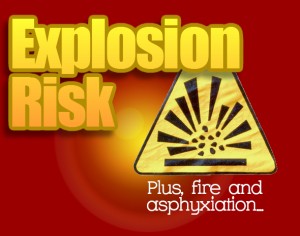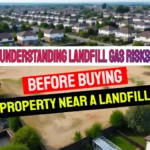 Landfill gas when emitted from a landfill gives rise to a list of possible impacts. Just think of the following attributes of landfill gas emissions each of which brings the risk of potential impacts of landfill gas emissions:
Landfill gas when emitted from a landfill gives rise to a list of possible impacts. Just think of the following attributes of landfill gas emissions each of which brings the risk of potential impacts of landfill gas emissions:
Landfill gas is;
- flammable,
- explosive after it is emitted, when in the right mixture with air (oxygen)
- an asphyiant devoid of oxygen in the same way as natural methane is once emitted and before it is mixed with air
- water vapour saturated
- may contain trace substances which are harmful with:
- acute short-term effects: if for example hydrogen sulphide is present in a significant quantity
- long-term effects: on the health of those within very close proximity to a plume of exhaust gas from the flair, and in particular to any landfill site workers who work within just a few metres of a landfill gas flare compound subjected to inhaling air with a mixture of clean air and the off-gas produced.
- and odorous (although methane itself is odorless).
So, if it escapes the landfill it can in very rare circumstances be a health hazard, as well as an odour nuisance to the local community. Landfill gas emissions can result in local air odour pollution, as well as harming the global environment due to the presence of greenhouse gases, including carbon dioxide and methane. The potential impacts of landfill gas can be summarized as follows:
Hazards of Landfill Gas Emissions:
Methane is flammable when mixed with air and can cause an explosion in a confined space, providing that there is a source of ignition. Landfill gas emissions can displace air (oxygen) causing a risk of asphyxiation to anybody entering the confined space. The ability of landfill gas to migrate from a landfill is dependent on many factors including viscosity and diffusivity of the gas itself, the physical characteristics of the waste (permeability, moisture content and porosity), as well as atmospheric temperature, pressure and gas concentration gradients.
The potential for Landfill gas to migrate from the landfill and cause a hazard to surrounding property was the initial reason for the development of Landfill gas extraction and control systems, and the many cases where during the 1980s in the UK, migration incidents occurred are well documented.
Nuisance:
The biggest nuisance landfill gas emission is odour. Trace compounds in landfill gas can be very malodorous, thereby causing nuisance to local communities.
Local environment damage:
The displacement of oxygen by landfill gas emission in the soil can induce plant phytotoxicity, where vegetation damage is a useful indicator of landfill gas migration from a site. In addition, condensate needs to be removed from the saturated gas before it is burnt, and this concentrate is highly corrosive and must be properly disposed.
Global environment damage:
Methane is a greenhouse gas which has an effect thirty times greater than the main greenhouse gas, carbon dioxide. Landfill sites are a major contributor to the global greenhouse effect (although not as significant as carbon dioxide from industry and transport), and the methane (Landfill gas) should be burnt and not allowed to vent to atmosphere.
Potential health effects:
Minor constituents of landfill gas can potentially have toxic effects but are rarely present in sufficient concentrations to present a health hazard.
However, there is increasing concern for people living near landfill sites (e.g. in developing nations) if subjected to a continual localized presence landfill gas in air at inhalation height and with the advent of huge mega-landfills this hazard increases.
The European Union Directive regulates landfill gas emissions in the directive on the Landfilling of Waste which was passed by Council in April 1999. It prohibits the free venting of landfill gas and has been applied across the 15 European Union countries since April 2001. It prevents all future, and existing landfill sites which were operational (operating under a permit) at that time, from being operated by free venting. Instead every regulated landfill must a functioning landfill gas extraction system and have a compliant design of enclosed flaring system.
It requires all new non-hazardous landfill sites to be at least 500m from property, and new hazardous landfill sites to be at least 2km from property.
Old landfills which were already closed (and the operator had handed back the licence) when this directive came into force but which may still be emitting landfill gas, were not included, although in principle these should also be made to comply.
All landfill site owners and operators should take landfill gas emissions seriously and this list of potential impacts shows why.
Other Pages You May Find Interesting:
[catlist]
Landfill Site Permit Applications – The Role of Risk Assessments in Emissions Control
Landfill site emissions risk assessments are a mandatory requirement for environmental permit applications (previously known as Landfill Site PPC Applications). They identify possible hazards to the environment and public health from landfill gas and leachate. The procedure calls for a thorough examination of landfill emissions, including assessments of the effects on the air, groundwater, and surface […]
Understanding Landfill Gas Risks Before Buying Property Near a Landfill
Buying Real Estate: Understand Landfill Gas Risks before buying land near a landfill! Landfill sites can produce methane, and that can continue for many years. It has been a known issue for years. Site operators used to see small landfill gas fires as minor problems when they first started to happen in the 1970s in […]
Landfill Gas Migration Defined and Explained
Landfill gas migration is defined as the process which occurs when the landfill gas generated within a landfill moves from the site of original waste deposition out of the landfilled waste, into the surrounding environment. This may take place as a result of the gas flow induced by the positive gas pressure produced by the […]
Fugitive Emissions of Methane and Landfill Gas Explained
It is well known that fugitive emissions of methane and landfill gas occur when methane escapes from production facilities, wells, pipes, compressors and other equipment associated with coal mining or natural gas extraction, landfills, and biogas plants. It is obviously very important to reduce fugitive emissions to an absolute minimum. Why are Fugitive Escapes of […]









Hi. I have checked your landfill-gas.com
and i see you’ve fallen for the lies of
big corporations once again. Warmer air =
quicker growth in nature = problem will
solve itself but big business must make money
out of their scare stories.